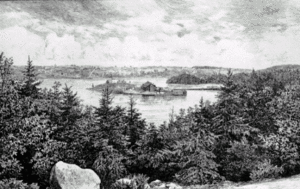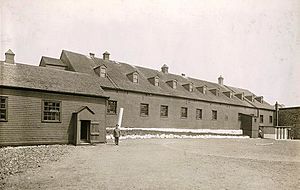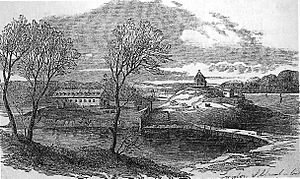Melville Island (Nova Scotia) facts for kids
Melville Island is a small piece of land in Nova Scotia, Canada. It's like a mini-peninsula located in the Northwest Arm of Halifax Harbour. You can find it west of Deadman's Island. It is part of the Halifax Regional Municipality.
People from Europe first found this spot in the 1600s. However, Indigenous peoples probably explored it much earlier. The land is quite rocky and has thin, acidic soil. Still, some trees and plants grow there.
Melville Island was first used for storage buildings. Then, the British bought it. They built a camp to hold prisoners during the Napoleonic Wars and later the War of 1812. The prisoners who died were buried on Deadman's Island nearby.
Later, Melville Island became a place for Black refugees. These were people escaping slavery in the United States. After that, it was a hospital for immigrants arriving from Europe, especially Ireland. It was a place where sick people were kept separate to stop diseases from spreading.
For a short time, it was a place where people joined the British Foreign Legion during the Crimean War. Then, it was sold back to the British to be a military prison. In 1907, the land went to the Canadian government. They used it to hold German and Austro-Hungarian people during the First World War. During the Second World War, prisoners went to McNabs Island instead. Melville Island was used to store ammunition.
Today, the Armdale Yacht Club has its clubhouse and marina on Melville Island. The island's history, especially its time as a prison, has been featured in many stories and artworks.
Contents
Where is Melville Island?
Melville Island is in the Halifax Regional Municipality in Nova Scotia. It sits on the eastern edge of Melville Cove. This cove is part of the Northwest Arm, which is a water channel between the Halifax Peninsula and Mainland Halifax.
The island covers about 2,000 square meters (21,500 square feet). It is about 200 meters (656 feet) west of Deadman's Island. The land is on a crack in the Earth's crust called a fracture zone. This area also shows signs of glaciers scraping the land a long time ago. The seabed around the island is made of gravel and muddy gravel. The shore is rocky.
Water Around the Island
The water around Melville Island is salty. It can be 15°C (59°F) in summer. In winter, it can freeze partly or completely. The water is quite polluted from sewage from Halifax. It looks olive brown to greenish black. The water around the island is about 4.5 to 10.5 meters (15 to 34 feet) deep.
Plants and Animals
Melville Island has thin and acidic soil. You can find plants like witherod, Indian pear, Labrador tea, wintergreen, and blueberry bushes. It is a wooded area with birch, tamarack, maple, oak, beech, and white pine trees.
Most of the island was paved in 1971 by the Armdale Yacht Club. So, most plant growth is now limited to the hill where the main clubhouse sits. Fish like cod and mackerel are caught near Melville Island. Birds such as grebes, loons, and alcids live here.
Weather and Climate
There is no weather station directly on Melville Island. However, it has a humid continental climate. This means it has warm summers and cold winters. The weather is strongly affected by the water temperature in Halifax Harbour.
Average air temperatures range from -4.4°C (24°F) in January to 18.9°C (66°F) in August. The island gets about 1,500 mm (59 inches) of rain or snow each year. Snow can fall from October through April. The area is somewhat protected. However, it can still be damaged by strong storms like Hurricane Juan in 2003.
History of Melville Island
Early Days
Indigenous peoples, especially the Mi'kmaq people, lived in the Halifax area as early as 7000 BC. But there is no proof they lived on Melville Island before Europeans arrived. The first Europeans to reach the island were likely French traders in the 1600s. The British founded Halifax in 1749.
The first recorded use of Melville Island was in 1752. Robert Cowie and John Aubony received permission to build a storehouse there. After Cowie died, the island was sold a few times. In 1784, James Kavanagh, a successful fisherman, bought it for £65. It was then known as Cowie's Island.
French Revolutionary Wars (1793–1801)
In 1793, a war started between Britain and France. Nova Scotia's Governor John Wentworth rented Kavanagh's Island. He planned to house 600 French prisoners captured from St. Pierre and Miquelon. However, the military commander objected. The prisoners were first held in Halifax. Some escaped, and the rest were sent away in 1794.
Later in 1794, a French ship with prisoners arrived in Halifax. People in the city worried about "fever" spreading. So, a surgeon named John Halliburton rented Kavanagh's Island. By 1795, 70 sick and wounded prisoners were sent to a makeshift hospital there. Other prisoners stayed on a prison ship.
Soldiers guarded the hospital starting in 1796. Some prisoners from the ship caused trouble in Halifax. They were sent to Kavanagh's Island. In 1801, a peace treaty meant most prisoners returned to France. The site was then left empty.
Napoleonic Wars (1803–1811)
In 1803, more French prisoners arrived in Halifax during the Napoleonic Wars. The island was formally leased for them. Many were sent to England or Bermuda. One surgeon, Antoine Noel, was hired to care for them. Some prisoners managed to escape.
Melville Island was bought for £1000 in 1804. This is like £89,970 today. It was bought by Robert Murray, who worked for the British Navy. The island was officially renamed Melville Island in late 1804 or early 1805. This honored Henry Dundas, Viscount Melville, a top naval official.
A wooden military prison was built for common prisoners. Its first stone was laid in 1808. This stone is still a monument today. A larger building was designed for officers. The prison quickly became too crowded. Some Spanish prisoners were also held there.
When prisoners arrived, their names and details were recorded. They wore yellow clothes to show they were prisoners of war. They received food like beef, bread, potatoes, and salt. Some officers could trade goods in Halifax or work as servants. There were also prisoner-run shops and a "small town fair" on Melville Island. British officers and Halifax residents visited these. Prisoners also enjoyed lotteries, building model ships, brewing beer, fishing, and making candy. Some even had pets or chickens.
In 1805, some officers broke their promise not to escape. This led to stricter rules. More serious punishments included whipping or being locked in a dark cell called the "Black Hole." This cell had only bread and water. Escapes were common. Other prisoners admired those who tried to escape. Before 1812, about 130 prisoners escaped. Only 11 were caught again. Many others were sent to prisons elsewhere or released after promising loyalty to Britain.
About 1,535 French prisoners were held at Melville between 1803 and 1813. Sixty-six Frenchmen died in the prison. Nine Spanish prisoners also died.
War of 1812
The War of 1812 brought many American prisoners to Melville Island. Up to 1,800 Americans were held there at one time. They stayed in barracks or on a nearby prison ship. Most French prisoners were released to make space for the Americans.
Early in the war, many Americans were exchanged for British prisoners. African-American captives were not exchanged. They were often released under a law that ended the slave trade.
By the end of 1812, maps showed many more buildings on the island. These included a prison, a hospital, officers' quarters, and guard houses. Even with more buildings, the prison was very crowded. This was made worse by trying to separate French and African-American prisoners from the white American majority. Over 2,000 prisoners were recorded by the end of 1812. More than 3,000 arrived over the next two years.
Stories about prison life differ. Some say prisoners were "well treated." Others say conditions were "wretched." Authorities tried to keep prisoners quiet. They even lied to them sometimes. Prisoners' letters were read. The barracks were full of lice. Prisoners slept in hammocks stacked three or four high. Their activities were more limited than earlier French prisoners. Strict cleaning rules were followed to keep things sanitary. Prisoners could be put in solitary confinement for being unclean. Food portions were considered "robust." Prisoners received about 0.45 kg (1 pound) each of bread and beef daily. They also got a small amount of peas.
In October 1812, John Mitchell was appointed to look after American prisoners. He arranged exchanges. He gave Americans coffee, sugar, potatoes, tobacco, newspapers, and soap. He also provided money for other purchases. Mitchell was in charge of buying clothes. But he didn't have enough money. In late 1813, almost 1,000 prisoners had no shoes. Many others had no jackets. A sickness outbreak was blamed on "want of comfortable clothing."
Despite the conditions, Americans continued the French tradition of setting up shops inside the prison. They sold cigars and smuggled rum. Gambling was popular, along with dancing, singing, and storytelling. One prisoner even made fake Spanish coins. On Sundays, church services were held. Visitors were allowed. Many visitors were loyal to Britain and came to see what they called "rebels."
In 1813, 320 American survivors from the capture of USS Chesapeake were sent to Melville Island. Their ship was used to take prisoners from Melville to a prison in England. Many officers were allowed to stay in Halifax. But some caused a riot. After this, rules for officers were made stricter. They had to attend a monthly check-in on Melville Island. Those who broke rules were sent to the prison.
After escape plans were stopped in 1813 and 1814, security was increased. 600 prisoners were sent to England. By the end of the war, over 10,000 French, Spanish, and American prisoners had been held at Melville. Most were Americans, with 8,148 recorded US prisoners.
Of the American prisoners, 195 died, mostly from fevers and pneumonia. This was a death rate of two percent. This rate was lower than for many British soldiers in North America. Prison conditions were also better than many British prisoners faced in US camps. Most French and American dead were buried on nearby Deadman's Island. The war ended in December 1814. But news didn't reach Melville until March 1815. About 50 prisoners died during this time.
Prisoners were released to leave Halifax on their own. Some found spots on trade ships. By mid-April, almost all had left. The remaining hospital patients were sent to a hospital in Halifax in May. Melville Island was closed as a prison in May 1815. Its goods were sold.
Receiving Depot
After the prison closed, Melville Island became a place for Black refugees. These were estimated to be 1,600 to 2,000 enslaved people who escaped and arrived in Halifax between 1815 and 1818. In April 1815, 76 refugees moved to Melville. Many were sick with smallpox.
The refugees received blankets, colorful clothing, and children's shoes. Food included pork or beef, potatoes, rice, cornmeal, molasses, and spruce beer to prevent sickness. Only heads of families received food. This was to encourage men to stay with their families. Eighty-two refugees died during the smallpox outbreak. Five hundred were vaccinated.
More refugees passed through Melville Island on their way to Canadian settlements. Between 727 and 798 were recorded from April to July 1815. Most found work in Halifax or moved to land grants. But some returned in winter when they needed help. At least 107 refugees died on Melville Island. The hospital officially closed in June 1816.
Starting in 1818, Melville Island was used as a hospital for sick immigrants. It was open for short times in 1818, 1831, and 1846. By 1829, ten buildings were left, all in poor condition. In 1831, three doctors cared for smallpox patients there. Only 16 patients were treated.
In 1847, over 1,200 Irish immigrants fleeing the Great Famine were ordered to stay on Melville Island. Of these, 203 were in the "fever hospital," and 30 died. People with typhus were also held there. Medical staff could not leave to prevent spreading the infection. Diseases included smallpox, typhus, and yellow fever. There were 37 recorded deaths.
British Army Use
In 1855, a politician named Joseph Howe planned to use Melville Island. It would be a place to recruit American soldiers for the British in the Crimean War. US laws prevented Americans from fighting in overseas wars. So, recruiters pretended to hire men for the Nova Scotia Railway.
When men arrived in Halifax, they went to Melville Island for training. The first group of 66 men arrived in April 1855. They all refused to join the British Foreign Legion. But by the end of May, 71 new soldiers had joined. Up to 158 total had enlisted. The US government was unhappy about this. The project was stopped in June. The Melville Island depot closed. Recruits were sent to England. Overall, 500 to 700 men were recruited, mostly German and Irish.
After this, the British Navy sold the land to the British army for £2,800. This is like £267,500 today. It was used as a military prison. The first 70 prisoners arrived in 1856. At this time, whipping was being stopped as a punishment for soldiers. Imprisonment was used instead. Melville Island allowed these prisoners to be moved from the crowded Halifax Citadel.
A 22-man military guard watched the prisoners. They had to do hard labor. They broke 500 tons of granite. Punishments included solitary confinement. Or, prisoners had to carry heavy cannonballs from one end of the yard to the other. A new prison building with 34 cells was built in 1884. There were some escape attempts. The most violent involved prisoners using stone hammers as weapons.
British officers inspected the prison four times a year. Prisoners or soldiers did maintenance. The prison also had a schoolroom and a chapel. A new stone prison was built before 1905. It was next to the older wooden barracks. Housing for guards and their families was also built. The new building fixed problems with lighting and air in the old one.
In December 1905, the Canadian Permanent Force took over the prison. There were only three prisoners left then. The land was given to the Canadian Government in 1907. This was when the British left Nova Scotia. In 1909, the name changed from "military prison" to "detention barracks." This showed a change in how military prisoners were seen. They were called detainees, not prisoners. After leaving the military, they had no permanent criminal record.
World Wars
When the First World War began in 1914, Canadian police could hold German and Austro-Hungarian people. They could imprison anyone who refused to promise not to support their home countries. In September, a Spanish ship carrying about 80 men going to Germany was stopped. The men were taken to Melville Island. They were questioned and imprisoned.
Over the next months, more German people were brought to Melville. Escape attempts started in October. Prisoners were counted twice daily to prevent escapes. The English-speaking guards often could not talk to prisoners or say their names. This made managing prisoners harder. Repairs were made after some inmates escaped by sawing a hole in the floor.
At first, prisoners could not send letters. Censorship was handled by police in Ottawa. The American Consul helped with prisoner welfare. As the war went on, groups of detainees were moved to other prisons. This depended on their behavior or risk level. After the 1917 Halifax Explosion, prisoners were moved to a large camp in Amherst, Nova Scotia. Some believe Leon Trotsky was one of the prisoners moved, but this is debated.
On April 10, 1935, a fire completely destroyed the old wooden prison barracks. So, when the Second World War began in 1939, remaining prisoners and guards went to McNab's Island. Melville Island was first used for soldiers who left the army without permission. From 1941, it stored Canadian Army ammunition. When VE Day caused riots in downtown Halifax, there were rumors of a plan to break into the depots. Soldiers were sent to guard against this, but no "invasion" happened.
1945 to Today
After the Second World War, military activities on Melville Island stopped. The land was first given to the Naval Sailors Association. This caused some debate among politicians. People in Halifax wanted the area used for fun activities. They were also worried about toxic chemicals being stored there.
In 1947, the Canadian Army leased Melville Island to the Armdale Yacht Club. The club paid Can$1 per year. The club tore down some buildings. They fixed and expanded others. They widened the road and added new land for boating. More renovations happened in 1952 and the 1960s. Verandahs were added to the two clubhouses. Their insides were remodeled. One clubhouse dates back to 1808 and was a warden's house.
The club's lease was yearly at first. But in 1956, they got a 99-year lease from the Department of National Defence. The club deepened Melville Cove. They added a "marine railway" and built a large marina. Dozens of boats are now docked there.
Culture and the Island
At certain times, Melville Island was a popular place for Halifax residents to visit. People from Halifax went to the "town fair" run by French prisoners during the Napoleonic period. An 1855 newspaper called the peninsula a "great resort of the ladies of Halifax."
However, from the start of the First World War until 1947, visitors to Melville were not allowed. It reopened when the Armdale Yacht Club arrived. But the area's history was mostly forgotten. This changed in 2000 with the creation of Deadman's Island Park next door.
The island has also been featured in art and books. Some writings by Melville prisoners have been saved. These include a diary by François-Lambert Bourneuf. Politician Joseph Howe wrote a poem about its use as a military prison. The island's history is the subject of books by Brian Cuthbertson, and by Iris Shea and Heather Watts. The prison is shown in a painting owned by the UK National Trust. It is also mentioned in a Nova Scotian folk song.
Images for kids











